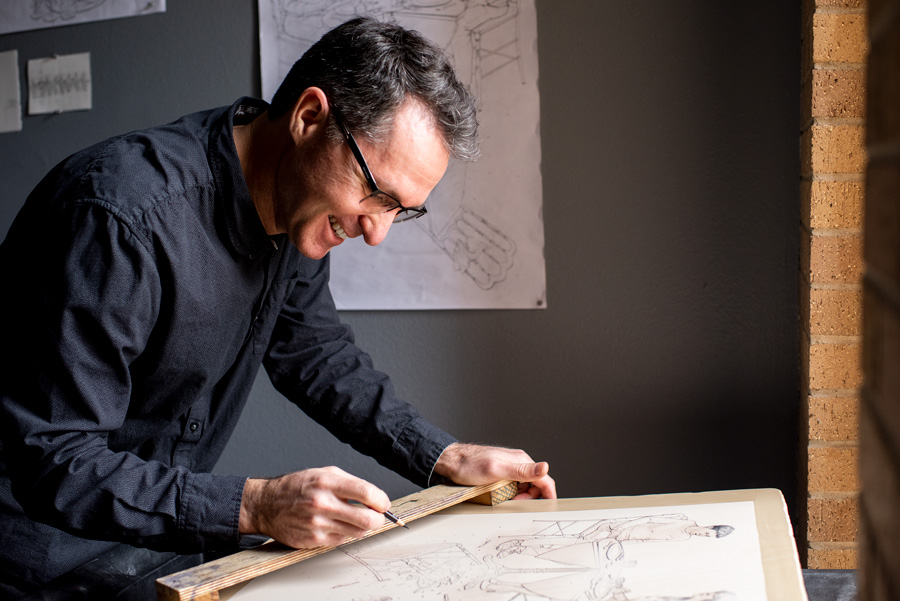
A family eats dinner together at a long table in one of Andrew DeCaen's print series, Gathering.
In one image, some family members are missing. In another version, one woman sits by herself. And in another, one man sits by himself at a shortened table and the chair is knocked over.
DeCaen, associate professor of art in UNT's College of Visual Arts and Design, uses printmaking to explore the universal practice of eating. But the food is often secondary to the story he portrays.
"Rituals and habits are really interesting to me," he says. "They tell us about so much about ourselves in how we interact."
DeCaen began making artworks around themes of eating in the early 2000s. Printmaking gives him the flexibility to experiment with the images and turn them into sculptures. Gathering, for example, was printed on paper and folded into the shape of Christmas crackers.
In Burn Handle, a woman building a campfire inside a kitchen is printed on an oven mitt. Whopperjawed Meal depicts a woman feasting on a plate of pasta with a schematic line drawing of a cafeteria tray -- which can be cut and folded -- superimposed over her. DeCaen also has turned his art literally into popcorn bags and a little kitchen.
In Thoroughly Populated Universe, made for an exhibition at the Kurt Vonnegut Museum, a young man eats on the floor by himself while other people sit at tables. The young man is loosely based on a character in Vonnegut's novel Slapstick who feels connected to his twin sister, but feels lonely in a crowd. A schematic line drawing for the chair overlays the image to explore "how we never quite achieve perfection of a plan," DeCaen says.
He strives to keep his artwork open-ended so viewers can determine the meaning.
"I hope they find something familiar, but also kind of awkward," he says. "I want to create something that feels unexpected."
His technique involves making several drafts of an image before transferring a line drawing to the limestone, then shading the drawing and chemically sealing the image so that he can print from the stone. This can take weeks or more and is physically laborious. The process is repeated for each color in the prints.
"The slowness of the process offers me an opportunity to invest in it differently than if I were making a drawing directly to paper," he says. "Like many things in life, doing something slowly often gives us a different way to appreciate, consider and engage the moment and activity."
DeCaen makes prints combining new and old technologies. During his residencies at Il Bisonte Foundation for Printmaking in Florence, Italy, and Tidaholm Lithographic Academy in central Sweden, he used antique presses while promoting and practicing stone lithography. He regularly attends national and international conferences and workshops to develop his skills and maintain currency in the process, history, and culture of fine art printmaking.
"I am always reading, watching films or finding new ways to investigate themes centered around food and eating," DeCaen says. "I aim to expand my understanding on various ways in which this mundane but essential activity can tell us who we are. The themes connect to ideas of religion, science, anthropology and psychology. The possibilities are endless."